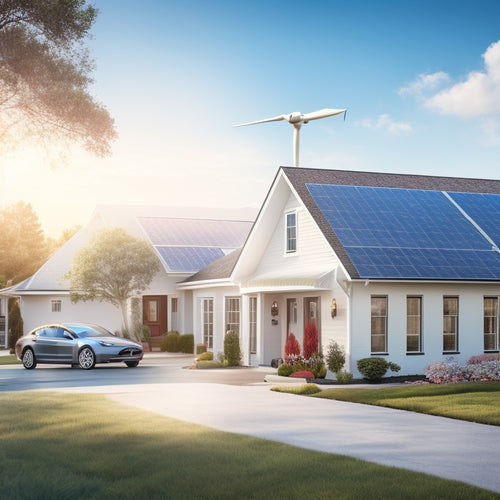
Diagnosing and Fixing Inverter Problems at Home
Share
You're about to diagnose and fix inverter problems at home. Start by identifying error codes and alarms, prioritizing system safety and performance. Check your inverter display screens, recalibrating for accurate readings. Verify your DC power input, ensuring it's within range and checking for fluctuations. From there, investigate grid connection problems, troubleshoot overheating issues, and solve ground fault problems. You'll also want to isolate noise problems, resolve communication errors, and understand shutdown patterns. With these steps, you'll be well on your way to identifying and fixing common inverter issues. Next, explore specific troubleshooting techniques to get your system up and running smoothly.
Key Takeaways
• Identify error codes and alarms on the inverter display screen and refer to the manual or online resources for diagnosis and repair.
• Check the DC power input to ensure the voltage is within the specified range and investigate any fluctuations or irregularities.
• Verify the grid connection settings, including voltage and frequency, to ensure proper synchronization and power flow.
• Inspect the inverter's cooling system, including fans and heat sinks, to prevent overheating issues and system failure.
• Isolate and troubleshoot specific problems, such as noise issues, grounding faults, or communication errors, to resolve inverter shutdowns and performance issues.
Identifying Error Codes and Alarms
When your inverter's display flashes an error code or sounds an alarm, you must quickly identify the problem to prevent further damage or safety risks. Don't panic, just follow this guide! Code analysis is key to solving the issue.
Start by noting the error code and looking it up in your inverter's manual or online documentation. If you're still stumped, try searching online for the code along with your inverter's model number.
Prioritize the alarms, focusing on the most vital ones first. If you're dealing with multiple alarms, tackle the ones that affect system safety and performance first. Remember, a false sense of security can be more dangerous than no security at all!
Alarm prioritization is essential to preventing further damage. By quickly identifying the problem, you'll be back to generating power in no time. So, take a deep breath, grab your troubleshooting hat, and get to work!
Checking Inverter Display Screens
Your inverter's display screen is a treasure trove of information, providing you with real-time data on system performance, voltage, and current output, so scrutinize it carefully to uncover potential issues. Take a close look at the display brightness – is it dim or overly bright? Adjust it to a comfortable level for best viewing. Now, inspect the screen for any signs of calibration issues. Is the display skewed or distorted? If so, recalibrate the screen to make sure accurate readings.
Here are some common display screen issues to watch out for:
| Issue | Symptom | Solution |
|---|---|---|
| Incorrect voltage reading | Voltage display shows incorrect values | Recalibrate the screen and check voltage sensors |
| Flickering display | Screen flickers or dims intermittently | Check display brightness settings and adjust as needed |
| Display not turning on | Screen remains blank or dark | Check power supply and display connections |
| Inaccurate current output | Current output display shows incorrect values | Check current sensors and recalibrate the screen |
| Screen calibration issues | Display is distorted or skewed | Recalibrate the screen and check display settings |
Verifying DC Power Input Issues
With your inverter's display screen checked and calibrated, you can now shift your attention to the DC power input, ensuring it's receiving the correct voltage and current from the solar panels or other DC sources. You'll want to verify that the DC voltage is within the inverter's specified range, usually between 300-450 volts. Any deviations could indicate DC power input issues.
Check the DC voltage using a multimeter, paying attention to any power fluctuations that might be causing the inverter to malfunction. Power fluctuations can be a real party pooper, causing your inverter to trip or shut down altogether.
If you notice any irregularities, investigating the source of the issue is crucial, whether it's a faulty solar panel or a wiring problem.
Investigating Grid Connection Problems
Examining the inverter's grid connection parameters is crucial in order to pinpoint the root cause of grid connection issues that may present as faulty synchronization, incorrect phase rotation, or failed anti-islanding detection.
When investigating grid connection problems, you'll want to check the inverter's grid voltage settings to confirm they match the grid's voltage. A mismatch can cause the inverter to malfunction or not operate at all. You should also verify that the inverter is set to the correct grid frequency, usually 50 or 60 Hz, depending on your region.
Power fluctuations can also cause grid connection issues. If the grid voltage is fluctuating, the inverter may struggle to synchronize with the grid, leading to errors or shutdowns. Check your grid voltage with a multimeter to identify any fluctuations. If you find fluctuations, consult with your utility company to resolve the issue.
Troubleshooting Inverter Overheating
Identifying and fixing the issue is crucial before it leads to more severe problems. When troubleshooting inverter overheating, start by checking the obvious culprits: make sure the cooling fan is spinning, and the air vents are clear of debris.
If that's not the issue, it's time to get a bit more sophisticated. Thermal imaging can help you pinpoint hotspots within the inverter. This non-invasive technique can reveal temperature anomalies, allowing you to target your troubleshooting efforts.
Pay close attention to heat sinks, which are designed to dissipate heat efficiently. If you notice excessive heat buildup around these components, it may indicate a faulty heat sink or inadequate airflow.
Solving Ground Fault Issues
When you're dealing with a ground fault issue, it's essential to identify the root cause to prevent further damage.
You'll need to investigate possible causes, such as faulty wiring or component failure, to pinpoint the problem.
Ground Fault Causes
Ground faults occur when the inverter's AC output unintentionally contacts the grounding system due to various factors such as faulty wiring, worn-out components, and improper installation. Troubleshooting requires identifying the root cause to prevent recurrence. Moisture intrusion is a common culprit, seeping into electrical components and causing ground faults due to improper sealing or damaged components.
Arc faults, another common cause, happen when an electrical current jumps between conductors, creating a spark. Loose connections, overheated wires, or rodent damage can trigger arc faults. Fixing the issue involves addressing the underlying cause through rewiring, component replacement, or ensuring proper installation. Stay vigilant to quickly resume power generation!
Identifying Faulty Components
To identify the faulty components causing the ground fault, you'll need to systematically inspect the inverter's electrical components, starting from the AC output stage and working your way back to the DC input stage. This involves a thorough component testing process to pinpoint the culprit behind the fault.
Begin by checking the output stage's power transistors, capacitors, and resistors for any signs of overheating, burning, or physical damage. Perform a visual inspection, looking for any telltale signs of component failure, such as blown fuses or tripped circuit breakers.
Next, move on to the DC input stage, examining the input capacitors, rectifier diodes, and voltage regulators for any signs of failure. Conduct a failure analysis to determine the root cause of the fault. Are the components overheating due to excessive current draw? Are there signs of electrical arcing or corona discharge?
By methodically inspecting each component and analyzing the failure modes, you'll be able to identify the faulty component(s) and take corrective action to rectify the issue.
Resetting Ground Fault Protection
By resetting the ground fault protection, you'll be able to restore your inverter's normal operation and prevent future shutdowns. Ground fault issues can be frustrating, but don't worry, we're here to help!
To reset the ground fault protection, follow these steps:
-
Locate the reset button: Typically found on the inverter's control panel, this button is usually labeled 'Ground Fault Reset' or 'Fault Reset.'
-
Press and hold the reset button: Hold the button for 3-5 seconds to initiate the reset process.
-
Wait for the inverter to restart: The inverter will automatically restart once the reset is complete.
- Verify the fault protection mode: Make sure the inverter is set to the correct Fault Protection Mode (e.g., 'Ground Fault' or 'Earth Fault') to prevent future issues.
Dealing With Inverter Shutdowns
When your inverter suddenly shuts down, it is important to identify the cause quickly to minimize downtime and prevent further damage. You don't want to be stuck in the dark, literally! To get your inverter up and running again, you need to determine the shutdown pattern. Is it shutting down randomly or is there a pattern to it? Are you experiencing power cycling, where the inverter shuts down and restarts repeatedly?
Here are some common shutdown patterns to look out for:
| Shutdown Pattern | Possible Cause |
|---|---|
| Random shutdowns | Overheating, electrical noise, or faulty components |
| Shutdowns during peak usage | Overloading or voltage fluctuations |
| Shutdowns during startup | Faulty startup sequence or incorrect configuration |
| Shutdowns with error codes | Specific fault detected, check inverter manual for codes |
| Shutdowns with no error codes | Unknown fault, consult inverter manual or contact support |
Isolating Inverter Noise Problems
Your inverter's sudden shutdowns or erratic behavior may be symptoms of electrical noise problems, which can be notoriously difficult to diagnose and fix. Noise can wreak havoc on your inverter's performance, causing it to malfunction or even shut down entirely.
To isolate the issue, you'll need to identify the noise sources and determine their frequency.
Here are some key steps to help you isolate inverter noise problems:
-
Identify potential noise sources: Look for devices that could be generating electromagnetic interference (EMI) or radio-frequency interference (RFI), such as computers, televisions, or cordless phones.
-
Conduct frequency analysis: Use a spectrum analyzer or oscilloscope to measure the frequency of the noise and determine its impact on your inverter's performance.
-
Check for grounding issues: Make sure that your inverter is properly grounded to prevent noise from entering the system.
- Use noise-filtering devices: Install noise filters or surge protectors to reduce the impact of electrical noise on your inverter.
Resolving Inverter Communication Errors
Resolving Inverter Communication Errors
Inverter communication errors can arise from faulty wiring, incorrect settings, or outdated firmware, and identifying the root cause is crucial to resolving the issue efficiently. You'll want to rule out the obvious culprits first, like loose connections or incorrect modem compatibility.
Check that your inverter's communication settings match those of your modem – it's like ensuring you're speaking the same language.
Next, verify that your inverter's firmware is up-to-date. Outdated firmware can lead to communication breakdowns. Check the manufacturer's website for firmware updates and follow their instructions for installation. It's like updating your phone's operating system – you want to stay current to avoid glitches.
If the issue persists, consult your inverter's manual or contact the manufacturer's support team for guidance. They can help you troubleshoot or provide additional resources to get your inverter communicating smoothly again.
Frequently Asked Questions
Can I Fix Inverter Issues on My Own Without Professional Help?
You can fix inverter issues on your own, but only if you're DIY-confident and take safety precautions seriously; otherwise, don't risk getting zapped – it's not worth the shock, literally!
How Do I Reset My Inverter After a Fault or Error?
"When an error code flashes, don't panic! You'll need to initiate the reset process by switching off the inverter, waiting 30 seconds, and powering it back on - voilà, your inverter's good as new (fingers crossed)!"
What Is the Average Lifespan of a Solar Inverter?
You'll be relieved to know that a typical solar inverter lasts around 10-15 years, with some manufacturers offering warranty coverage for up to 25 years, ensuring your inverter durability and peace of mind.
Can I Use a Spare Inverter as a Temporary Replacement?
You're wondering if that spare inverter can save the day as a temporary replacement? Absolutely, you can swap it in as a backup solution, but verify compatible specs and proper installation to avoid new problems!
Will a Faulty Inverter Affect My Entire Solar Panel System?
"When an inverter fails, you'll likely see a dip in system performance, energy efficiency, and power reliability, potentially disrupting your grid connection - so yeah, a faulty inverter can definitely impact your entire solar panel system, buddy!"
Related Posts
-

Why Go Green With Automotive Products Online?
By switching to eco-friendly automotive products online, you're taking a significant step towards reducing your carbo...
-

Why Electric Motorcycles Fail at Long-Distance Touring
You're likely familiar with the excitement of hitting the open road on an electric motorcycle, but you're also smart ...
-

Why Homeowners Are Embracing DIY Energy Independence
By taking control of your energy needs, you're breaking free from the uncertainty of utility bills and embracing a se...


